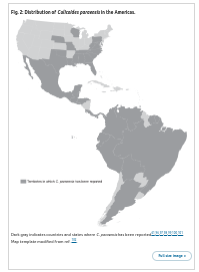
CDCHAN-00515
#18,249
Twenty-five years ago the West Nile Virus arrived in New York City - likely carried in by a traveler from the Middle East - and quickly established residence in local mosquitoes and birds, with spillovers into humans and horses.
Within a few years, WNV had spread across the nation, infecting hundreds of thousands of people. Most infections are mild, but a small percentage (1%) are neuroinvasive, and can be fatal (see DVBID: 2012 Record Number Of West Nile Fatalities).
In 2009, Dengue returned to the state of Florida for the first time in nearly 70 years, likely carried in by a traveler from an endemic region of the world. Since then we've see scattered outbreaks in Florida and Texas, including this summer (see CDC HAN # 00511: Increased Risk of Dengue Virus Infections in the United States).
We've seen similar outbreaks of Malaria, Chikungunya, and Zika. Typically these vector-borne diseases must be reintroduced into the local mosquito population every year. Only rarely (as with WNV) have they become endemic in the United States.
It generally requires repeated introductions, a competent vector (the `right kind' of mosquito/midge/tick, etc.), and one or more reservoir hosts. There are two primary ways that these types of viruses can spread; the Sylvatic (Jungle) Cycle and the Urban Cycle.
 | ||
| Credit CDC |
While little known outside of the Amazon until a few months ago, in May Cuba notified the WHO of an outbreak (n=74 cases) of the Oropouche virus.
This was followed in early August by a PAHO Epidemiological Alert (see below), warning of potential risks to fetuses, citing several cases of microcephaly and stillbirth potentially linked to maternal infection, reminiscent to what we saw with Zika.
Epidemiological Alert Oropouche in the Region of the Americas: vertical transmission event under investigation in Brazil - 17 July 2024
DOWNLOAD (221.22 KB)
In previous epidemiological updates, circulation of Oropouche virus (OROV) has been reported in several countries in the Region of the Americas. In this epidemiological alert the identification of possible cases of vertical transmission of OROV in Brazil, which are under investigation, are being reported. The Pan American Health Organization / World Health Organization (PAHO/WHO) urges Member States to remain alert to the occurrence of similar events in their territories and to notify their occurrence through the established communication channels under the International Health Regulations (IHR).
This week the CDC's Traveler's Health issued the following advisory:
Level 1 - Practice Usual Precautions
Map: Areas in South America with reported cases of Oropouche (see larger map)
What is Oropouche?
Oropouche is a disease caused by Oropouche virus. It is spread through the bites of infected midges (small flies) and mosquitoes.
Symptoms of Oropouche include headache, fever, muscle aches, stiff joints, nausea, vomiting, chills, or sensitivity to light. Severe cases may result in neuroinvasive disease such as meningitis.
Symptoms typically start 3–10 days after being bitten and last 3–6 days. Most people recover without long-term effects. There is no specific treatment for Oropouche.
- Key points
- Parts of Bolivia, Brazil, Colombia, and Peru (see map) are reporting cases of Oropouche, although the case numbers are declining.A Level 2 Travel Health Notice has been issued for Oropouche in Cuba.
- Oropouche is spread by the bite of infected midges (small flies) and mosquitoes.
- Travelers to affected areas should take steps to prevent bug bites.
- Illness can occur in people of any age and is often mistaken for dengue.
International Travel-Associated Oropouche Fever cases: Nine cases of Oropouche fever were reported this week in persons that had international travel. In 2024, 11 travel-associated Oropouche fever cases have been reported.
Late yesterday the CDC issued a HAN Advisory - primarily for clinicians and public health workers - on the increased risk of seeing imported Oropouche cases. Due to its length, I've only posted some excerpts. Follow the link to read it in its entirety.
Increased Oropouche Virus Activity and Associated Risk to Travelers
Distributed via the CDC Health Alert Network
August 16, 2024, 4:00 PM ET
CDCHAN-00515
Summary
The Centers for Disease Control and Prevention (CDC) is issuing this Health Alert Network (HAN) Health Advisory to notify clinicians and public health authorities of an increase in Oropouche virus disease in the Americas region, originating from endemic areas in the Amazon basin and new areas in South America and the Caribbean. Between January 1 and August 1, 2024, more than 8,000 cases of Oropouche virus disease were reported, including two deaths and five cases of vertical transmission associated with fetal death or congenital abnormalities. Countries reporting cases include Brazil, Bolivia, Peru, Colombia, and Cuba.
In the United States and Europe in 2024, travel-associated cases have been identified in travelers returning from Cuba and Brazil. As testing and surveillance for Oropouche virus disease increase in the Americas, reports of cases from additional countries are expected. This Health Advisory advises on evaluating and testing travelers who have been in impacted areas with signs and symptoms consistent with Oropouche virus infection. It also raises awareness of the possible risk of vertical transmission (e.g., from gestational parent to fetus during pregnancy) and associated adverse effects on pregnancy and highlights prevention measures to mitigate additional spread of the virus and potential importation into unaffected areas, including the United States.
No specific antiviral treatments or vaccines are available for Oropouche virus disease. Treatment for symptoms can include rest, fluids, and use of analgesics and antipyretics. Acetaminophen is the preferred first-line treatment for fever and pain. Aspirin and other non-steroidal anti-inflammatory drugs (NSAIDs) should not be used to reduce the risk of hemorrhage. Patients who develop more severe symptoms should be hospitalized for close observation and supportive treatment. Pregnant people with laboratory evidence of Oropouche virus infection should be monitored during pregnancy and live-born infants should be carefully evaluated.
Travelers to areas with Oropouche virus transmission should use prevention measures to avoid biting midge and mosquito exposure during travel and for 3 weeks after travel, or if infected during the first week of illness, to mitigate additional spread of the virus and potential importation into unaffected areas in the United States. Oropouche virus disease is not a nationally notifiable condition. However, CDC encourages jurisdictions to report voluntarily to ArboNET, the national arboviral disease surveillance system.
While it is currently believed the chances of Oropouche setting up shop in North America are pretty slim, they are not zero.
A recent (2022) study published in Nature reported found its primary vector - the biting midge Culicoides paraensis - in several U.S. States, and warned of its potential for further spread.
March 2022 npj Vaccines 7(1):38
DOI:10.1038/s41541-022-00456-2
License CC BY 4.0
Authors: Megan Files, Clairissa A. Hansen, Vanessa Herrera, Craig Schindewolf
Oropouche virus (OROV) is an arthropod-borne orthobunyavirus found in South America and causes Oropouche fever, a febrile infection similar to dengue. It is the second most prevalent arthropod-borne viral disease in South America after dengue. Over 500,000 cases have been diagnosed since the virus was first discovered in 1955; however, this is likely a significant underestimate given the limited availability of diagnostics.
No fatalities have been reported to date, however, up to 60% of cases have a recurrent phase of disease within one month of recovery from the primary disease course. The main arthropod vector is the biting midge Culicoides paraensis, which has a geographic range as far north as the United States and demonstrates the potential for OROV to geographically expand.
The transmission cycle is incompletely understood and vertebrate hosts include both non-human primates and birds further supporting the potential ability of the virus to spread. A number of candidate antivirals have been evaluated against OROV in vitro but none showed antiviral activity. Surprisingly, there is only one report in the literature on candidate vaccines.
We suggest that OROV is an undervalued pathogen much like chikungunya, Schmallenberg, and Zika viruses were before they emerged. Overall, OROV is an important emerging disease that has been under-investigated and has the potential to cause large epidemics in the future. Further research, in particular candidate vaccines, is needed for this important pathogen.
For now the biggest risk is to travelers to endemic regions, and to pregnant women in particular. But as international travel increases, so do the the risks of seeing more incursions of `exotic' diseases like Oropouche into North America, Europe, and beyond.



